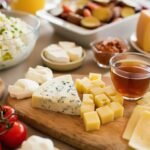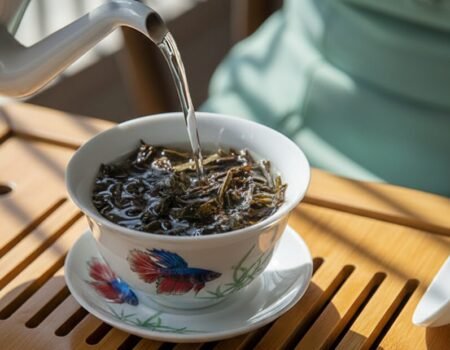
Brewing Oolong Tea: A Guide to Steeping the Finest Oolong Leaves from Taiwan
Index
Oolong tea sits between green and black tea on the oxidation scale, offering a unique taste profile with less astringency than other teas.
This guide will walk you through brewing methods for Taiwanese oolong, from water temperature to steeping times, so you can enjoy perfect cups every time.
Key Takeaways
- Oolong tea falls between green and black tea with 10–70% oxidation levels, offering less astringency and complex flavors.
- For Western-style brewing, use 5 grams of tea per 16 ounces (500 ml) of water at 195°F (~90°C) and steep for 3 minutes. lightly oxidized teas may use slightly cooler water 185–195°F (~85–90°C).
- Gongfu Cha method uses more leaves (5-7 grams per 100ml) with multiple short steeps of 30-45 seconds.
- Water quality matters – filtered or spring water produces better results than tap water with chlorine.
- Quality oolong leaves can be steeped 5-8 times (Gongfu Cha method), with each infusion revealing different flavor dimensions.
What Is Oolong Tea?
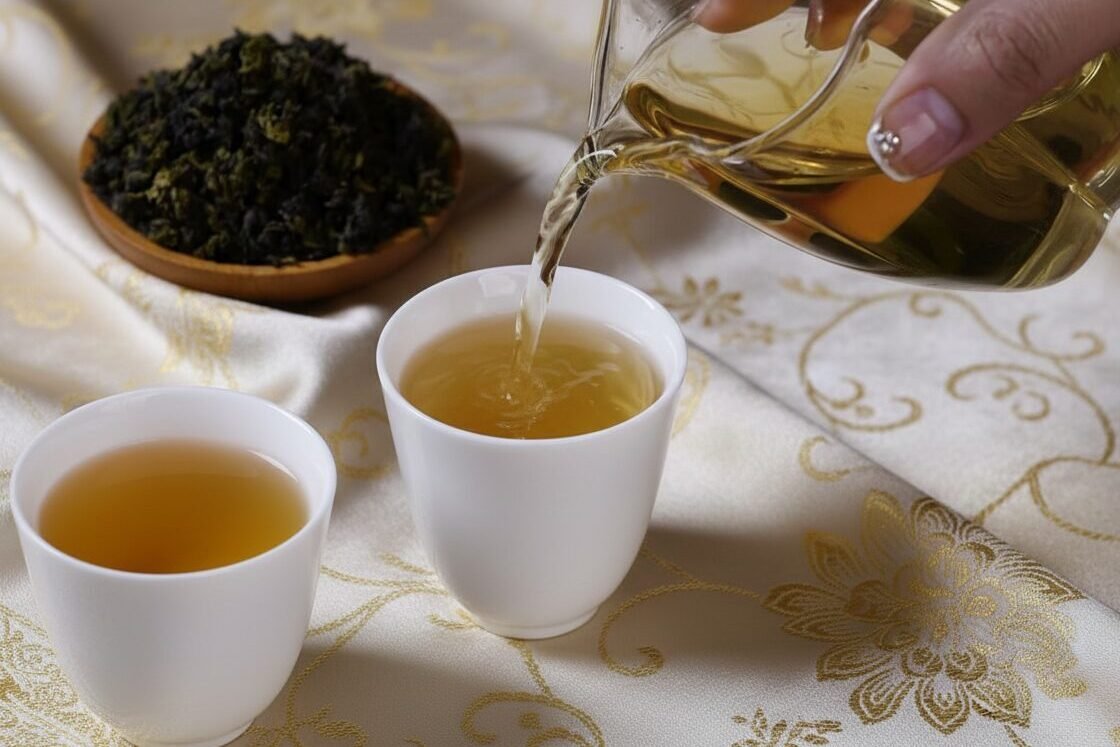
Oolong tea sits in the middle ground between green and black teas with 8-85% oxidation levels. This semi-oxidized leaf from the Camellia sinensis plant offers tea lovers a wide range of flavors.
Green oolongs with less than 45% oxidation bring bright notes of white flowers and fruits. Dark oolongs above 50% oxidation deliver deeper tastes of dried fruit, spice, and minerals.
Most quality oolongs come from Taiwan and China’s Fujian and Guangdong provinces, where tea masters craft these leaves with care.
You’ll notice oolong tea has fewer tannins than other tea types, which means less mouth-drying astringency in your cup. The leaves often appear tightly rolled or twisted, unfurling during brewing to release their complex flavors.
Taiwan produces some of the world’s finest oolongs, with varieties that can be steeped multiple times. Each infusion reveals new taste dimensions as the leaves continue to open. Now let’s explore the unique approaches to brewing these special leaves.
Unique Approaches to Brewing Oolong Tea
Oolong tea offers two distinct brewing paths that yield different flavor experiences. You can try the quick Western method with a standard teapot or explore the traditional Gongfu ceremony with special equipment like gaiwans or Yixing clay pots.
The Western-Style Brewing Method
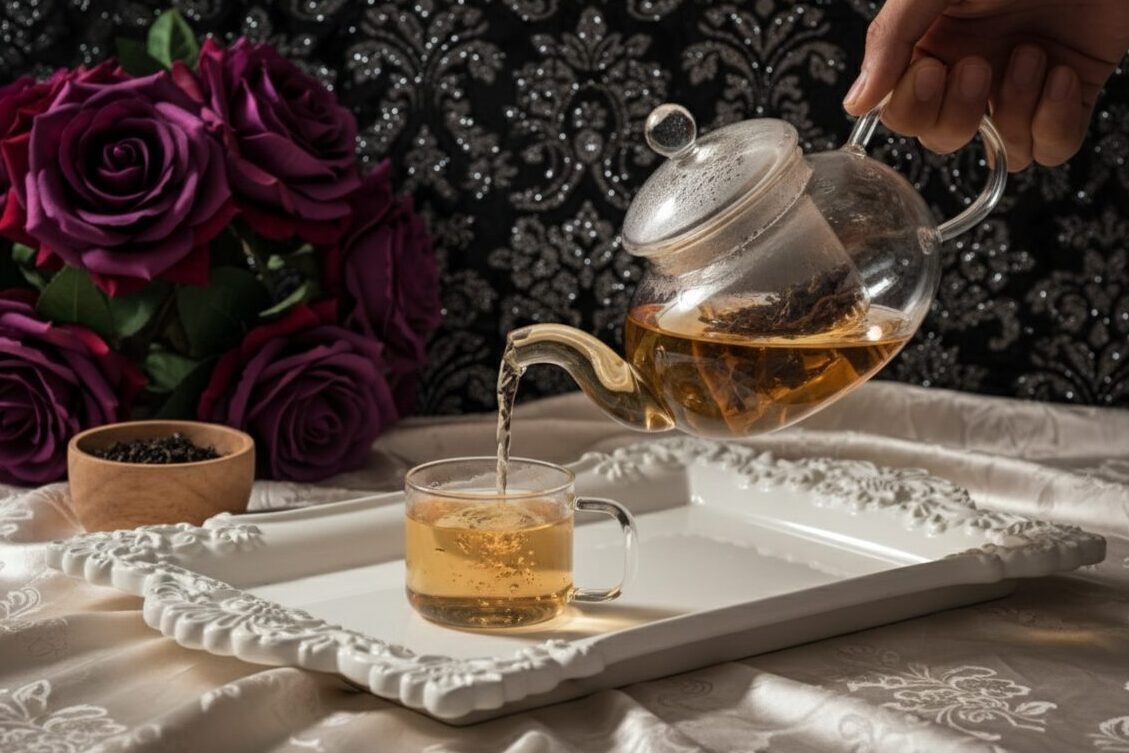
Western-style brewing offers a simpler approach to enjoying Taiwanese oolong tea. This method uses more water and fewer leaves than traditional Asian techniques, making it perfect for casual tea drinkers.
Essential Equipment & Setup
What You’ll Need:
- Glass teapot or large mug with basket infuser
- Kitchen scale or teaspoon for measuring
- Fresh, filtered or spring water (tap water can affect flavor)
- Heat source to reach 195°F (~90°C)
Space Considerations:
- Oolong leaves expand significantly during brewing
- Choose a vessel with ample room for leaves to unfurl completely
- A basket infuser in a large mug offers the simplest setup for beginners

The Brewing Process
Preparation & First Steep:
- Measure 5 grams (1-2 teaspoons) of loose leaf per 16 ounces (~500ml water)
- Pre-rinse your oolong with hot water for 5-10 seconds to awaken the leaves
- Pour 195°F (~90°C) water over the tea and steep for 3 minutes. For light oolongs, starting at less than 3 minutes in Western brewing might better capture subtle flavors
- Western brewing creates a full-bodied cup with rich flavors from this single, longer steep
Multiple Infusions:
- Remove all water from leaves after each steeping if you plan to reuse them
- The same leaves yield 5-6 more infusions
- Add 30 seconds to each subsequent steeping time
Getting the Best Results
Tea Selection & Visual Cues:
- Rolled oolongs from Taiwan excel with this method, releasing flavors gradually during longer steeps
- Your finished brew should display amber to golden hues, varying with the tea’s oxidation level
- We find that this western approach brings out different flavor notes than traditional gongfu brewing
Now let’s explore the Gongfu Cha ceremony, which takes a completely different approach to brewing these exceptional leaves.
The Gongfu Cha Tea Ceremony
While Western brewing focuses on simplicity, the Gongfu Cha method offers a deeper connection to Taiwanese tea traditions. This ancient Chinese tea ceremony transforms oolong brewing into an art form that brings out complex flavors through multiple short steepings.
Essential Gongfu Equipment
Core Tools Required:
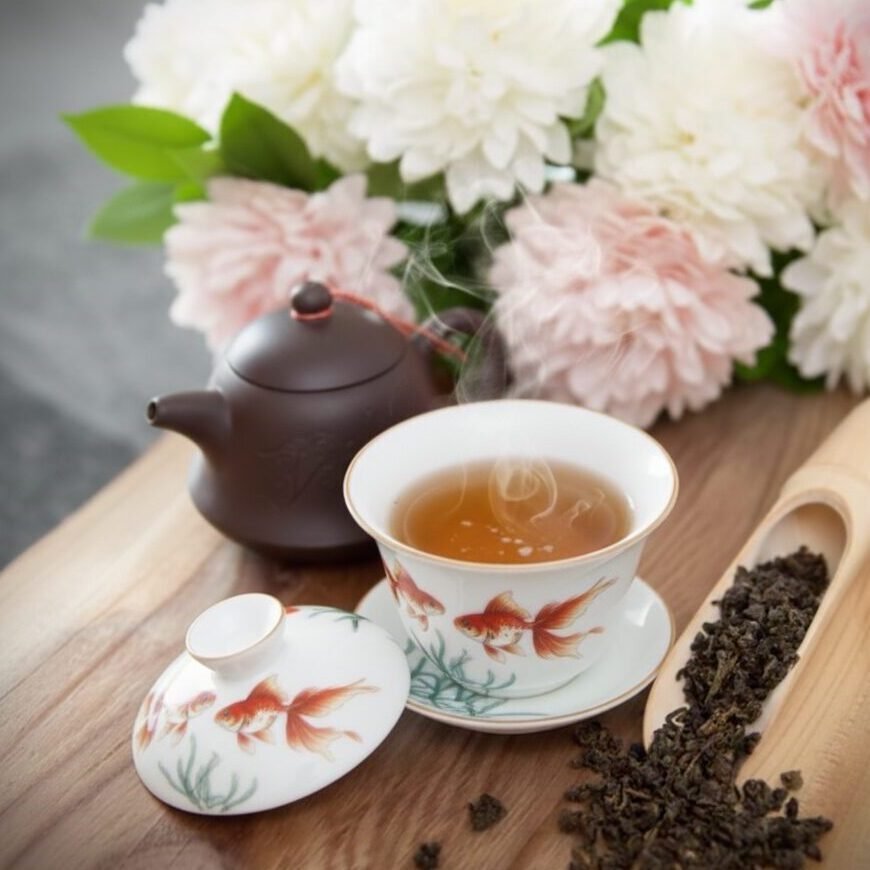
- Gaiwan or Yixing clay teapot (100-150ml capacity)
- Sharing pitcher (fairness cup) for even distribution
- Small tasting cups holding just one or two sips
- Tea boat or tray to catch spills during the ceremony
Water Quality:
- Filtered or spring water produces superior results
- Tap water’s chlorine can mask your oolong’s natural flavors
Preparation & Setup
Vessel Warming:
- Pour hot water over all tea vessels before brewing
- This prepares clay and porcelain to maintain optimal heat
- Warmed vessels preserve the tea’s temperature throughout service
Tea Proportions:
- Use 5-7 grams of loose leaf per 100ml water
- This higher leaf-to-water ratio extracts concentrated flavors
- We recommend starting with 5 grams and adjusting to your preference
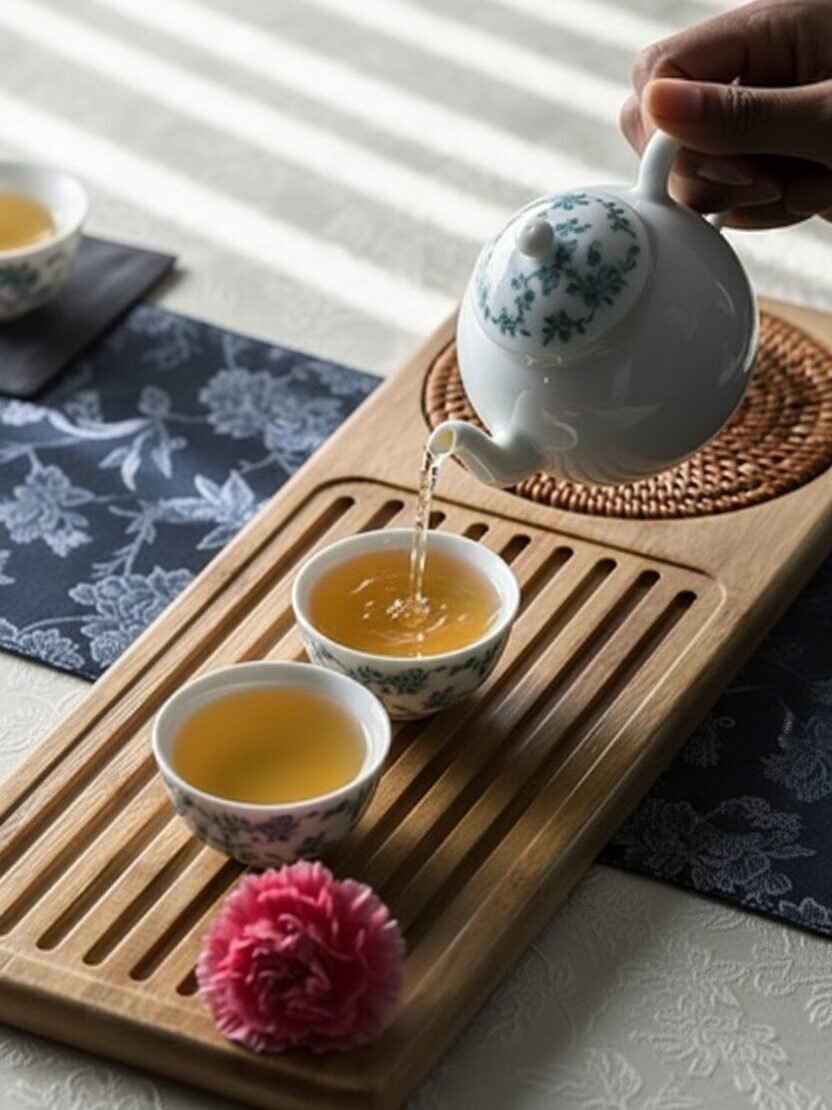
The Brewing Technique
Initial Steps:
- Rinse oolong leaves briefly with 195°F (~90°C) water and discard
- This “awakening” removes dust and begins leaf expansion
- Your first proper steep lasts only 30-45 seconds
Serving Method:
- Pour tea through a strainer into the sharing pitcher
- The pitcher ensures each person receives equal-strength tea
- Serve in small cups that encourage mindful sipping
Multiple Infusions:
- Quality oolong yields 5-8 distinctive infusions
- Increase steeping time by about 10 to 20 seconds with each subsequent infusion as leaves fully open
- Each infusion reveals different flavor layers: from floral notes to deeper, fruitier characteristics
The Gongfu Experience
Mindful Appreciation:
- Small cup size focuses attention on aroma, taste, and mouthfeel
- You’ll notice how your oolong transforms across successive steepings
- This method highlights the tea’s evolving character rather than consuming it quickly
Key Factors for Optimal Flavor
Several factors impact the flavor of your oolong tea. The right brewing method makes all the difference between a flat cup and one bursting with complex notes.
Ideal Water Temperature and Quality
| Oolong Type | Water Temperature | Notes |
|---|---|---|
| Light Oolong (e.g. Tieguanyin, Baozhong) | 175–185°F (80–85°C) | Use lower heat to bring out floral, sweet notes and avoid bitterness |
| Medium Oolong (e.g. Dong Ding, High Mountain) | 185–195°F (85–90°C) | Balanced extraction; highlights creamy and fruity body |
| Dark / Roasted Oolong (e.g. Da Hong Pao, Wuyi Rock, Aged) | 195–205°F (90–96°C) | Brings out deeper roasted, nutty, and mineral flavors |
| General Gongfu Range (All Styles) | 195–208°F (90–98°C) | Ideal for multiple short steepings in Gongfu Cha |
| Western-Style Average (for comparison) | ~195°F (~90°C) | Used for longer single infusions |
This range—175–208°F (80°-98°C) —covers nearly all oolong styles. Lower temperatures suit greener oolongs, while higher (near-boiling) water suits darker, roasted ones.
Water temperature plays a crucial role in brewing perfect oolong tea. Most oolong varieties reach their peak flavor at 195°F (~90°C), though lighter variety oolongs often need lower temperatures (~175–185°F / 80–85°C) for optimal flavor preservation.
Green oolongs like those from Taiwan need slightly cooler water to prevent bitterness. You can achieve the right temperature by letting boiled water rest for 1-2 minutes or using a kitchen thermometer for precision.

Many tea enthusiasts prefer this method over guesswork.
Water quality matters just as much as temperature for brewing oolong tea. Filtered or spring water creates a cleaner, more authentic taste profile compared to tap water with chlorine or minerals.
The purity of your water directly impacts how well the complex flavors of dancong or da hong pao oolongs develop during steeping. This attention to water quality becomes especially important during gongfu style brewing, where multiple infusions highlight subtle flavor changes in the leaves.
Recommended Steeping Times
While proper water temperature sets the foundation, precise steeping times unlock each oolong tea’s full potential. Different oolong varieties require specific timing to release their optimal flavors without becoming bitter or weak. Timing matters just as much as temperature for a perfect cup.
| Oolong Type | Western-Style Brewing | Gongfu Method | Flavor Notes |
|---|---|---|---|
| Light Oolong | 1-2 minutes | 30 seconds | Floral, sweet, delicate |
| Medium Oolong | 2-3 minutes | 45 seconds | Fruity, honey-like, balanced |
| Dark Oolong | 3-5 minutes | 1 minute | Woody, roasted, robust |
| Cold Brew (All Types) | 8-12 hours | Not applicable | Sweeter, smoother profile |
Many tea lovers appreciate oolong’s unique ability to withstand multiple steepings. Each infusion reveals new flavor dimensions from the same leaves. First steepings often highlight bright, top notes. Second and third steepings bring out deeper, more complex flavors. Some high-quality Taiwan oolongs can be steeped up to seven times, with each cup offering a slightly different experience.
For cold brewing, simply place oolong leaves in cold water and refrigerate overnight. This gentle extraction method creates a naturally sweet tea without any bitterness. Cold brewing works especially well with lighter oolongs from high mountain regions of Taiwan.
Experimenting with steeping times allows you to find your personal preference. Try adding or subtracting 30 seconds from the recommended times to discover how it affects the flavor profile of your favorite oolong tea.
Conclusion
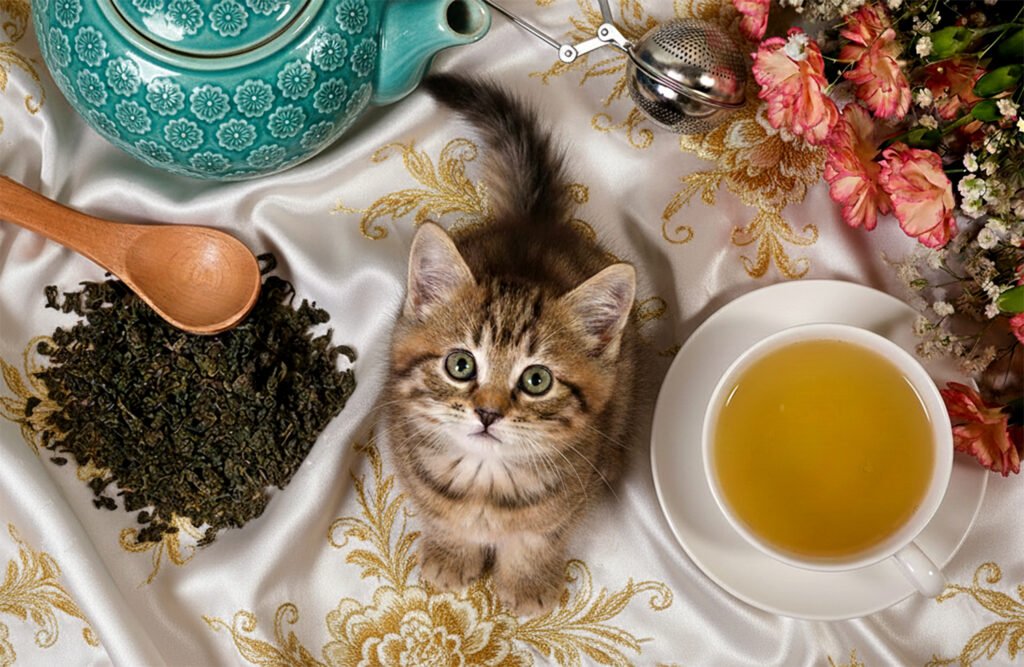
Brewing Taiwanese oolong tea balances art and science, with each cup offering a new discovery. You can start with the simple Western method or explore the rich traditions of Gongfu Cha based on your time and equipment.
Perfect your technique by paying attention to water quality, temperature, and steeping times for each variety. Experiment freely with these elements to find what pleases your taste buds most.
The journey of brewing oolong rewards patience, as each steep reveals new layers of flavor from these remarkable leaves.
FAQs
1. What’s the difference between light and dark oolong, and why do they brew differently?
This is based on the tea’s oxidation level. Light oolongs (like Baozhong) are less oxidized and have bright, floral notes, so they use cooler water. Dark oolongs (like Wuyi Rock) are more oxidized and roasted, giving them deeper, nutty, or fruity flavors, so they require hotter water to extract those notes.
2. What water temperature is best for brewing oolong tea?
The ideal temperature depends on the specific tea. The article provides this guide:
- Light Oolong: 175–185°F (80–85°C)
- Medium Oolong: 185–195°F (85–90°C)
- Dark / Roasted Oolong: 195–205°F (90–96°C)
3. How long should I steep oolong tea?
Steeping time varies by brewing method and tea type.
- Western-Style:
- Light Oolong: 1–2 minutes
- Medium Oolong: 2–3 minutes
- Dark Oolong: 3–5 minutes
- Gongfu Cha Method: Use very short steeps, starting around 30–45 seconds.
4. Do I need to rinse the tea leaves before brewing?
Yes, the article recommends a brief rinse for both methods. This “awakens” the leaves, removes any dust, and helps them begin to unfurl.
5. What is the right tea-to-water ratio for brewing oolong?
For the Western-style method, use 5 grams of tea per 16 ounces (500 ml) of water. For the Gongfu Cha method, use a much higher ratio of 5–7 grams of tea per 100 ml of water.
6. Can I use a regular teapot to brew oolong tea?
Yes. While Yixing clay pots or a gaiwan are used for the traditional Gongfu Cha ceremony, a regular teapot or a large mug with a basket infuser works perfectly for the Western-style brewing method.
7. Can oolong tea be re-steeped multiple times?
Absolutely. This is a key feature of quality oolong. Using the Gongfu method, leaves can be steeped 5–8 times, with each infusion revealing new flavors. For the Western method, you can also get multiple infusions, adding about 30 seconds to each new steep.
8. Is filtered water better than tap water for brewing oolong tea?
Yes, the article strongly recommends using filtered or spring water. Tap water often contains chlorine or minerals that can negatively affect the oolong’s complex and subtle flavors.
9. How do I cold brew oolong tea?
Place the oolong leaves in cold, filtered water and let them steep in the refrigerator for 8 to 12 hours (or overnight). This method produces a naturally sweet, smooth tea with no bitterness and is especially good with lighter oolongs.
References
- https://taiwanleaftea.com/info/how-to-brew-oolong
- https://www.whittard.com/it/discover/tea-tips/a-guide-to-oolong-tea.html
- https://www.saratogateaandhoney.com/blogs/how-to-brew-tea/how-to-brew-oolong?srsltid=AfmBOopzFcy94iV2yc456OMAYbBpDIuRZr3qDeT7SoFF7lg6xHQ2ZrmK
- https://eco-cha.com/blogs/news/gong-fu-brewing-guide-for-the-best-taiwanese-tea?srsltid=AfmBOorHTeYO4RlPGmQi0MzS_CQ0iY36Mqq7qoCLSGpcTyNfJVdhJwHP (2018-08-27)
- https://tea-side.com/blog/how-to-make-oolong-tea/ (2019-01-10)
- https://backyardbrew.com/blogs/tea/water-temperature-for-brewing-tea?srsltid=AfmBOoqjsiFh5ZGlgu05uTmo8E4S4mxnZ0c2L9YWfd6MVbiExXMyR9uQ
- https://symphonyofleavestea.com/the-ultimate-guide-to-loose-leaf-oolong-tea-from-harvest-to-your-cup/
- https://www.redrockteahouse.com/blogs/articles/the-ultimate-guide-to-brewing-oolong-tea?srsltid=AfmBOoqaY4A47y-9-AQnWW9hWL7od0s6VwrG3R9_wbKGy8925QqgVQcl (2025-03-14)
- https://artfultea.com/blogs/101/loose-leaf-tea-steep-time?srsltid=AfmBOorFYQenyTFdXsi8XgDlfipYyga4IkjSULyKjpY2QvimZ-lDCFQI

